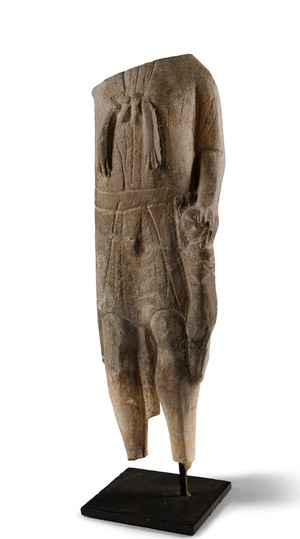Cypriot Limestone figure of Heracles/Melqart: Cypro-Archaic II – Cypro-Classical I (500-400 BC)
Originally c.48cm high (missing right arm, head, and feet), from South-West Cyprus, probably Kition or Idalion, this votive offering has an almost featureless, flat back and was intended to be seen only from the front, probably in a shrine.
The Phoenician god Melqart (meaning King of the City) was the tutelary and founding god-hero of Tyre and subsequently other Phoenician colonies, such as Kition. He was often depicted dressed in lion-skin and loincloth, and bearing an ankh or flower, and a fenestrated axe, symbols of life and death, but in a style quite different to this. He may have been the source of some stories about the demi-god Heracles, also a wearer of a lion-skin (referring to his killing of the Nemean lion) and became identified with him later by the Greeks. It is possible the characteristics of both gods were initially grafted onto a local deity, known variously as The Master of Animals, Master of the Lion, the Great God of Cyprus, the Cypriot Heracles, or even the Cypriot Reshef. In Cyprus he is usually depicted with Heracles’ club and/or bow, as on the coins of the city-kingdom of Kition, the Phoenician colony which may have been the source of this synthesis, and which had a temple dedicated to him (see ... ).
This figurine, though rather flat is, a characteristic Cypriot type, found in several smaller limestone sculptures, including several from Golgoi. One of those found at Kition and two from the Sanctuary of Apollo at Idalion (which Kition conquered between 470-450 BC) are almost identical in their detail. Unfortunately the lack of the head makes it hard to date more precisely from the eye shape. In this type his hand rests on the head of a small lion stretched down his thigh, his right arm (here missing) raised in the ‘smiting’ pose, wielding a club, with the lion skin’s forelegs knotted across his chest and identical short-sleeved belted tunic. In all versions the lion skin hangs down behind, the head forming his hat.
Cf. British Museum 1917,0701.285 and 1873,0320.38; Karageorgis 2003 p.236 cat.274; Museo Giovanni Barracco, Rome, Inv. MB63; Cyprus Museum ref? ; C Bonnet 1988.
Size: 34.5 cm (as now)
(Dispersal of large collection from Cambridge bought mainly from well known Auction houses before 2000, then by descent.)
(Aquired Acquired by DJ: Timeline Auction 5th March lot 0088)
(DJ 270 AN 250)

